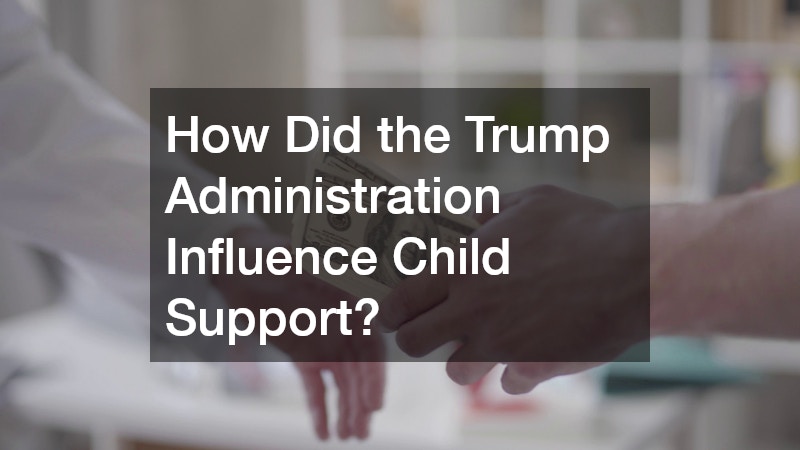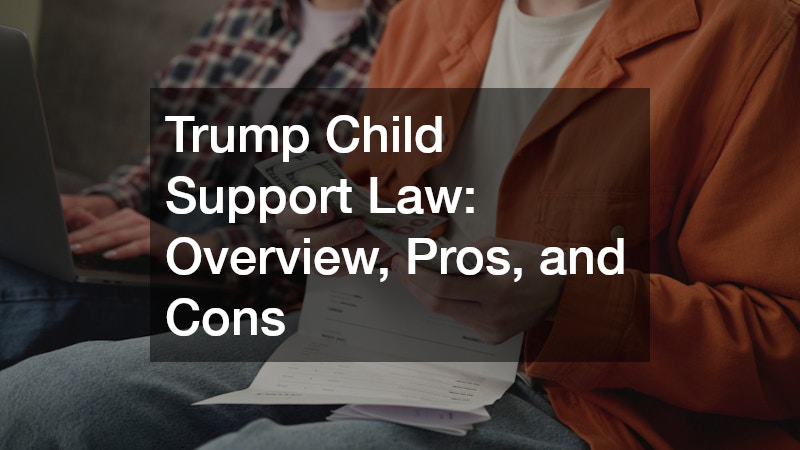When President Donald Trump held office, several administrative reforms were proposed and enacted that touched on family law, including child support enforcement. While not branded officially as the “Trump Child Support Law,” the term has come to refer to regulatory adjustments during his administration, primarily affecting enforcement, data collection, and support guidelines. The goal was to increase accountability, reduce government dependency, and modernize child support systems through digital infrastructure and better cross-agency communication.
Though these changes didn’t rewrite the federal child support law entirely, they did influence how states administered support orders—particularly concerning income verification, interstate enforcement, and non-custodial parental rights. As we move into 2025, these Trump-era frameworks are still part of the conversation, especially in the context of the new child support laws 2025, which aim to refine and expand on previous reforms.
How Did the Trump Administration Influence Child Support?

During the Trump administration, child support reform was seen as part of a broader goal to encourage parental responsibility while reducing government welfare costs. Some of the major actions taken or influenced during this time include:
- Updated enforcement procedures: The administration supported stronger digital tracking systems to locate parents who owe child support.
- Data-driven collections: More emphasis was placed on using tax and employment databases to verify income and assets.
- Encouraging shared parenting: In some states, Trump-aligned policymakers advocated for laws that presumed 50/50 custody, which can influence support calculations.
- Reduced penalties for poor parents: In 2018, rules were proposed to avoid penalizing low-income noncustodial parents who were unable to pay due to hardship.
While these changes were not universally applied, they set the tone for how many state legislatures approached child support laws over the last few years.
Why Do People Call It the “Trump Child Support Law”?
Although there was no single legislative act passed that was titled the “Trump Child Support Law,” the nickname emerged due to a series of executive actions and administrative rules focused on reforming the child support system during his presidency. These changes included:
- A push for states to modernize outdated systems.
- More aggressive pursuit of delinquent payments.
- Greater flexibility for states to set their own child support guidelines.
This collective movement shaped how both supporters and critics referred to Trump’s influence on child support law. It’s important to note that most child support laws are state-governed, but federal policies heavily influence the standards and enforcement mechanisms used across the U.S.
Pros of the Trump Child Support Reforms
There were clear advantages to the child support changes associated with the Trump administration, especially from a systems and accountability standpoint. Key benefits included:
-
Improved enforcement technology
Digital tracking systems helped child support agencies locate delinquent parents more efficiently and reduce fraud.
-
Streamlined income verification
By accessing federal databases, states could more accurately determine a parent’s ability to pay, reducing errors in support orders.
-
Flexibility for states
States gained more autonomy in setting enforcement rules, allowing them to tailor systems based on demographic and economic needs.
-
Relief for low-income parents
Some states, inspired by federal recommendations, implemented safeguards to ensure that struggling parents weren’t unfairly jailed for non-payment.
Cons of the Trump Child Support Reforms
Despite these improvements, the reforms were not without controversy. Critics argue that the changes didn’t go far enough to address systemic inequalities in child support enforcement. Some of the cons included:
-
Inconsistent application across states
Because many reforms relied on state implementation, results varied widely, leading to inequality in enforcement and fairness.
-
Potential for aggressive enforcement
Stronger data tools sometimes led to overly punitive measures against parents with temporary income loss or informal work arrangements.
-
Lack of direct financial support
Unlike other family-centered reforms, Trump’s changes focused more on enforcement than on supporting low-income custodial families directly.
How Do These Reforms Compare to the New Child Support Laws 2025?
The new child support laws of 2025 build on some of the structural changes introduced during the Trump era, but with a renewed focus on fairness and economic balance. Key differences include:
- Self-support reserve requirements to ensure payers retain enough income to live on.
- Graduated payment options for parents facing financial hardship.
- More support for custodial parents in accessing benefits and housing tied to child support payments.
These 2025 laws are viewed as a continuation and improvement of earlier reforms, aiming to make the system more humane while still holding parents accountable.
What Should Parents Know Moving Forward?

If you are a parent involved in a child support case, it’s important to stay informed about both federal influences and your specific state’s laws. Whether you’re dealing with enforcement issues, payment modifications, or custody adjustments, consider the following:
- Stay updated: Monitor your state’s child support website for current laws and reforms.
- Know your rights: Legal aid services can help non-custodial parents understand their obligations and avoid unfair penalties.
- Keep good records: Always track payments and communication related to support obligations.
With child support laws evolving, particularly following the Trump administration and into 2025, understanding both the history and future trajectory is key to staying compliant and protecting your family’s well-being.

